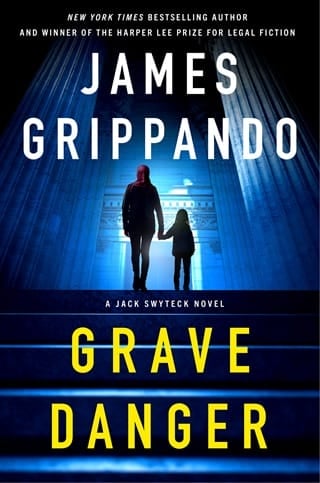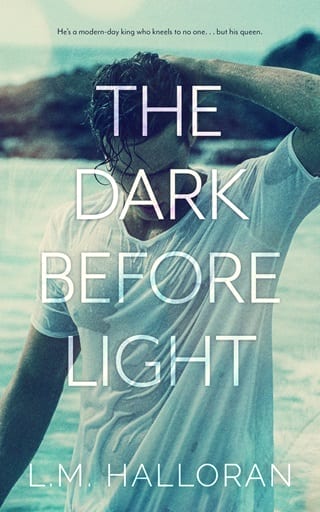Chapter 30
A stony silence filled the near-empty courtroom. Jack could only imagine what was going through Yasmin’s mind, as she stared
out from her seat on the witness stand. Her hands were in her lap, clenching the doll from the judge’s chambers, her eyes
wide with fear.
“Mr. Swyteck, you may proceed,” Judge Carlton said.
Jack chose not to rise. He would question the witness from his chair, seated right beside her mother. His aim was to be as
nonthreatening as possible.
“Thank you, Your Honor. And hi, Yasmin.”
“Hello,” she said softly.
Jack had examined child witnesses before in other cases. It was never easy. The image depicted in Yasmin’s drawing made it
even more difficult in this case. Jack was still trying to wrap his mind around it.
“Can you hear me okay, Yasmin?”
“Uh-huh.”
“Not too loud or too soft?”
“No.”
“Good. So, it’s just right. You’re Goldilocks today, Yasmin. Everything should be just right. You let me know if it’s not,
okay?”
She gave him a little smile, but it was a nervous one.
Jack eased into things, first getting her to talk about the visit to Judge Carlton’s chambers. His questions were purely conversational,
intended only to reduce her stress, eliciting nothing that he didn’t already know from having watched by camera. Then he turned
to the matter at hand.
“I want to talk about the drawings you made for Judge Carlton,” said Jack.
“Okay.”
“The first one was a drawing of your friends at school, right?”
“Yes.”
“The judge tells me that was a really good drawing.”
“Thank you.”
“The one we’re here to talk about is the third one,” said Jack. “The one you drew all by yourself, when no one was around.”
Yasmin averted her eyes. Jack gave her a moment, and the judge interjected.
“We’ll mark this as exhibit 1,” the judge said, and then he addressed the court-appointed psychiatrist, who was seated to
the side. “Dr. Emanuel, could you please come forward and provide the witness with a copy?”
The psychiatrist complied. Yasmin took the drawing and looked at it, saying nothing. Jack placed his copy flat on the table
in front of him.
“Did you make that drawing, Yasmin?”
“Yes.”
“Why did you make this drawing?”
“I dunno. I just did.”
“That’s fine,” said Jack, and he was suddenly thinking about Righley, and not just because of the way she said “I dunno.”
Righley had an art teacher who liked to teach her class how to look at art. “IAI,” she’d say; “Identify, analyze, interpret.”
Jack started with the “I.”
“First, I just want you to tell me what’s in the picture. I see three people, is that right?”
“Yes.”
“The person in the middle is a grown-up, right?”
“Mm-hmm.”
“You labeled her ‘Mommy.’ Is that your mommy?”
“Yes.”
“Next to her is another grown-up, right?”
“Yes.”
“You labeled that one ‘Him.’ Is ‘Him’ a man?”
“Yes.”
“Who is the person you labeled ‘Him’?”
Yasmin glanced in Farid’s direction, then looked away quickly. She didn’t answer verbally, but it was answer enough.
“Is ‘Him’ in the courtroom now?”
“Yes.”
“Okay, we will leave it at that, for now. I see a third person in the drawing. A smaller person. You labeled that one ‘Me.’
Is ‘Me’ you, Yasmin?”
“Yes.”
Jack paused. Step two of the IAI method: analyze. His focus shifted to the lines and techniques the artist used to convey
the intended image.
“It looks to me like Mommy and Him are right next to each other, right?”
“Yes.”
“But ‘Me’ is off to the side. Is that you standing off to the side, Yasmin?”
“Uh-huh.”
“Why are you off to the side?”
“Afraid.”
“Afraid of what?”
“Him.”
“Why are you afraid of him?”
Yasmin didn’t answer. Jack tried another approach.
“Your mommy has short hair in this drawing. Is the mommy in this picture sitting in this courtroom now?”
“No.”
“The mommy sitting in this courtroom has long hair, right?”
“Yes.”
“Who is the mommy with short hair in your picture?”
“Mommy before.”
“Did the ‘mommy before’ always have short hair?”
“No.”
“How did she get short hair?”
“She cut it.”
“With what?”
Yasmin shifted nervously in the chair. “The scissors.”
“With the scissors you drew in your picture?”
“Uh-huh.”
Jack knew the next few questions were critical—and that they would be most difficult for his witness. “Yasmin, why is the
man labeled ‘Him’ holding the scissors?”
Farid’s lawyer rose. “Judge, I have to object.”
Jack had expected as much. He was moving to the final step of the IAI method, from “identify” and “analyze” to “interpret.”
“Let’s hear the answer,” said the judge. “Yasmin, the question is, ‘Why is the man labeled ‘Him’ holding the scissors?”
Yasmin hesitated. She almost froze.
Jack asked again, more gently. “Can you tell us why, Yasmin?”
Yasmin struggled, clearly digging deep for the answer. “Because he doesn’t like her hair.”
“Is the man mad in your picture?”
“Objection, leading.”
“Overruled. Yes, it’s leading, counsel. But again, the witness is a child. Let’s keep the objections to a minimum, please.
Continue, Mr. Swyteck.”
“Is the man in your picture mad?” Jack asked again.
“Uh-huh.”
“Is he mad at Mommy?”
She nodded.
Jack continued. “Is the man saying anything?”
She nodded again.
“Is his voice soft?” Jack asked. “Or is it loud?”
Yasmin’s voice tightened. “Loud. Real loud.”
“When I take a good look at the figure you labeled ‘Me,’ it looks like she has her hands over her ears. Am I right?”
“Uh-huh.”
“Why?”
“Because it’s so loud.”
“Were you afraid?” Jack asked.
“Yeah.”
“Afraid of what?”
She didn’t answer, but again she glanced nervously in Farid’s direction. Jack was concerned that she might shut down if he
pushed too hard for an answer. But there was one more important point to make.
“In your drawing, the man is holding the scissors. He’s holding them high in the air, right?”
She nodded.
“Above Mommy’s head,” said Jack.
She didn’t answer.
“What is he doing with the scissors?”
She started to tremble.
“Did you see what he did with the scissors, Yasmin?”
She was trembling, but she managed a little nod.
“Yasmin, what did he do with the scissors?”
Her eyes welled, and a sudden scream filled the courtroom. “ Mommy! ”
Farid launched from his chair. “This never happened!” he shouted.
It was the first and only time Farid had displayed a temper in these proceedings, and Yasmin cowered on the witness stand.
Farid’s lawyer tried to reel him in, almost forcing him back into his seat, but she addressed the court with equal anger.
“Judge, this is outrageous! This child has obviously been coached!”
Jack remained seated, so as not to overwhelm Yasmin, but he spoke forcefully. “Judge, there has been no coaching. That was
the whole point of the process you adopted here. Yasmin drew the picture alone in your chambers, and she was immediately put
on the witness stand to answer questions about it, having spent no time alone with me or my client to prepare.”
“I demand the right to cross-examine,” said Beech.
The psychiatrist rose—to protect Yasmin from further trauma, Jack presumed—but the judge was one step ahead of everyone else.
“We’re not going to do that,” the judge said.
“But you said I would have the right to question the witness,” said Beech.
“Obviously, the circumstances have changed,” the judge said, and then he put on his grandfatherly face to address the witness.
“You’re a brave girl, Yasmin. Dr. Emanuel is going to take you back to my chambers, and you’ll be safe there.”
The doctor followed the judge’s directive. She and Yasmin disappeared through the side door to the chambers. Judge Carlton
continued.
“To be clear, I am not going to make a finding on the record that Farid Bazzi murdered Ava Bazzi, his first wife. I won’t
even go so far as to find that Mr. Bazzi stabbed or otherwise physically harmed her. But it is clear enough from the testimony
today that Mr. Bazzi threatened or otherwise ‘abused’ Ava for cutting her hair in protest of the hijab laws. The key point
is that the abuse—whatever form it took—was done in the presence of the child. Witnessing the abuse of the mother constitutes
grave danger of psychological harm to a child within the meaning of the Hague Convention—which is a complete defense against
a father’s claim of unlawful abduction.”
Zahra’s grip on Jack’s arm tightened. She could read the tea leaves as well as he could.
“This court finds that returning the child, Yasmin Bazzi, to her father, Farid Bazzi, would put the child at grave risk of
physical or psychological harm. I therefore rule in favor of the respondent, Zahra Bazzi. We are adjourned,” he said, ending
with a crack of his gavel.
The bailiff gave the command to rise, but both sides were already standing.
“It’s over?” Zahra asked, breathless.
“It’s over,” Jack whispered.
His client shrieked so loudly that Jack’s ears started ringing.
“Order, please,” the judge said.
Jack got his client under control. The judge stepped down from the bench and exited to his chambers. Before Zahra could say
“Thank you,” Farid’s lawyer crossed quickly to Jack’s side of the courtroom for a lawyer-to-lawyer moment.
“This is far from over, Swyteck.”
“Yeah, good luck with your appeal,” said Jack.
“Appeal? Right,” she said with a smirk. “You really don’t know how this game is played, do you?”
She turned and walked back to her client.
“What did she mean by that?” Zahra asked.
Jack had his own ideas, but none that he was ready to share. “Nothing,” he said. “Sore loser.”
 Fullepub
Fullepub 



